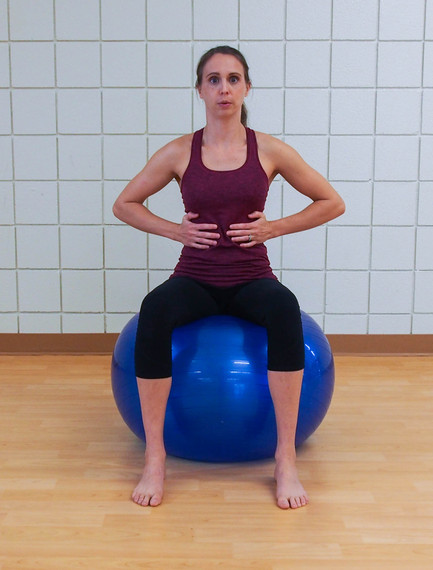If you're like most women, you spend your time in the grocery store line flipping through magazines or checking Facebook. But what if I told you this is the perfect time to work on your pelvic floor... without anyone knowing what you're doing? (And I'm not talking about Kegels here, but something far more effective.)
Whether they know it or not, many women have a weak pelvic floor that may manifest as SI joint dysfunction, hip pain, or just accepting "sneeze pee" as normal. They may also think that if they just do enough Kegels, it will fix their weakness.
But here's the thing: The pelvic floor is not a standalone part of your body that only needs to be strengthened by doing Kegels; it's an integrated part of your entire kinetic chain. And that means it's connected to everything, and not just connected, but influenced by all the structures in the body, which can impact the pelvic floor positively or negatively.
You can strengthen the pelvic floor by tapping into this system!
That's where the grocery store line comes in. You're busy, and you don't have a lot of time to devote to strengthening your pelvic floor, so steal those extra minutes while you wait in line to work through these five tips:
#1 -- Let go of your glutes (butt muscles)! Many women have an unconscious tendency to clench or hold their glutes tight when standing. This "tucking" action is horrible for the correct function of the pelvic floor and can also cause hip and back pain.
Glute clenching usually happens because you have a weak stability system, so your glutes are kicking in to try and help, but that's not their job. To fix this, squeeze your glutes and then let them go, fully relaxing them. This brings awareness that they were being clenched, and often all the body needs is a little awareness to promote positive change!
#2 -- Keep from drawing in your belly button. Really? Is that still recommended? A properly functioning pelvic floor needs the perfect amount of pressure in your abdominal cavity. This allows the diaphragm to expand fully and the pelvic floor to respond to that expansion.
If you're drawing in your belly button, it messes with this system and creates a diaphragm and pelvic floor dysfunction. An example of this is trying to drink out of a juice box with a straw: If you squeeze the middle, you squirt out the juice!
To fix this issue, let that belly button go, but don't let it hang out! Instead, you want to slightly lift your lower abdominal area, and try to get your belly button to face upward rather than the floor. Doing this will give support to both your pelvis and lower back while allowing you to breathe properly and maintain perfect pressure for an awesome pelvic floor.
#3 -- Maintain proper alignment of the entire spine! Bones rely on muscles to move them, which means that how you carry your body by contracting your muscles (upright vs. slouching) is extremely important -- and of course, we're looking for upright.
So instead of hanging on the cart and slouching while you wait in line, support your pelvic floor with perfect posture and align your system. This helps your rib cage stack properly over your pelvis, and allows everything to work efficiently.
To fix your alignment, think about pulling a string out of the crown of your head from your lower abdominal area. This should slightly tuck your chin and lengthen your spine. Not only will this support your pelvic floor, it will relieve tension from your neck and lower back and also make you look like you just lost 5 pounds!
#4 -- Take time to really breathe. Deep breathing is not all about belly breathing. The diaphragm must expand all around the body, not just in the front. Remember, the diaphragm and pelvic floor work together like a piston system, and if you're a shallow breather you never tap into this system.
If you do not properly expand your diaphragm, then the pelvic floor gets weaker by default because there is no pressure pushing down to create strength by response. This tells your pelvic floor it can take a break and doesn't need to fully expand and contract, and can be a big issue for leaking when you cough or sneeze.
To fix this issue, focus on deep breathing and getting that full 360-degree expansion of your diaphragm. If you are a shallow breather, start by placing your hands on your belly and feeling that move with every breathe. Once you master this, place your hands around the bottom of your ribcage, and as you inhale, feel your ribs expand in the front, sides and back of your body.
#5 -- Channel your inner Shakira and get those hips rotating. Hip strength is crucial to a strong pelvic floor, and when the hips rotate, they stimulate the pelvic floor into action.
Hip motion tells the pelvic floor to kick in and stabilize the pelvis, creating a stimulus that in turn makes the pelvic floor stronger.
To fix this issue, I want you to focus on bending and twisting through your hips as you unload the groceries. Use caution though; I don't want you bending and twisting through your lower back! Try instead to stick out your butt and pivot through your hips to reach into the cart and turn to put the groceries in the car. The more you can get your hips moving the more the pelvic floor wakes up and subsequently gets stronger!
Now that you've seen how tapping into your kinetic chain can benefit your pelvic floor, I bet you'll be heading for the longest checkout line you can find just to get in these five tips.
***
Sarah's a wife, mom and adventure sports athlete who fixes people. She teaches women how to strengthen their body in ways that produce maximum results without wasting time. Her passion is about helping women to quit ineffective exercises that are not achieving the change they want so they can feel stronger, experience less aches and pains and have more time for the things they love!
Sarah is the founder of Core Exercise Solutions and was recently named to the top innovative therapist list in North America, and when she's not hanging off the side of a mountain Sarah is writing, presenting or figuring out how her patients can continue to pursue their dreams and lead strong, adventurous lives.
To learn more about her approach to the Pelvic Floor, check out her Pelvic Floor Video Series here.

